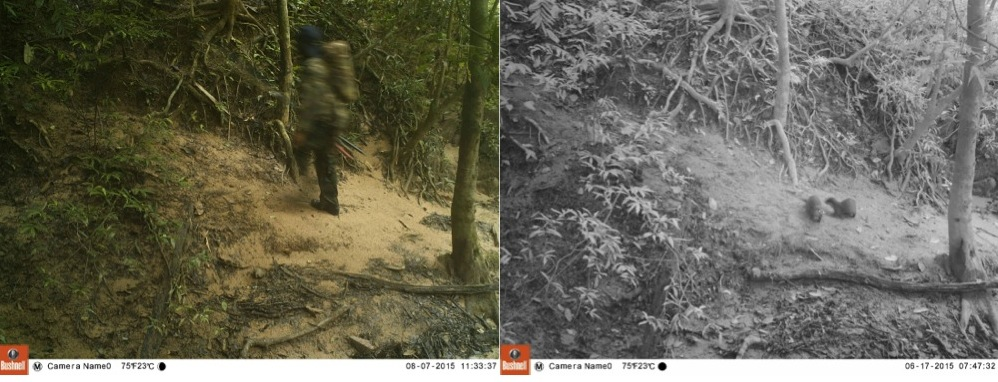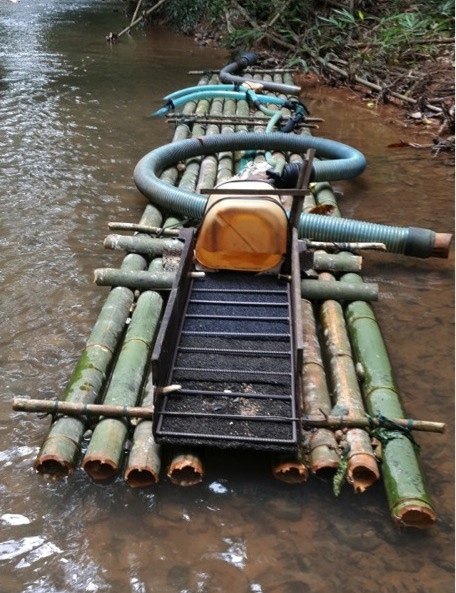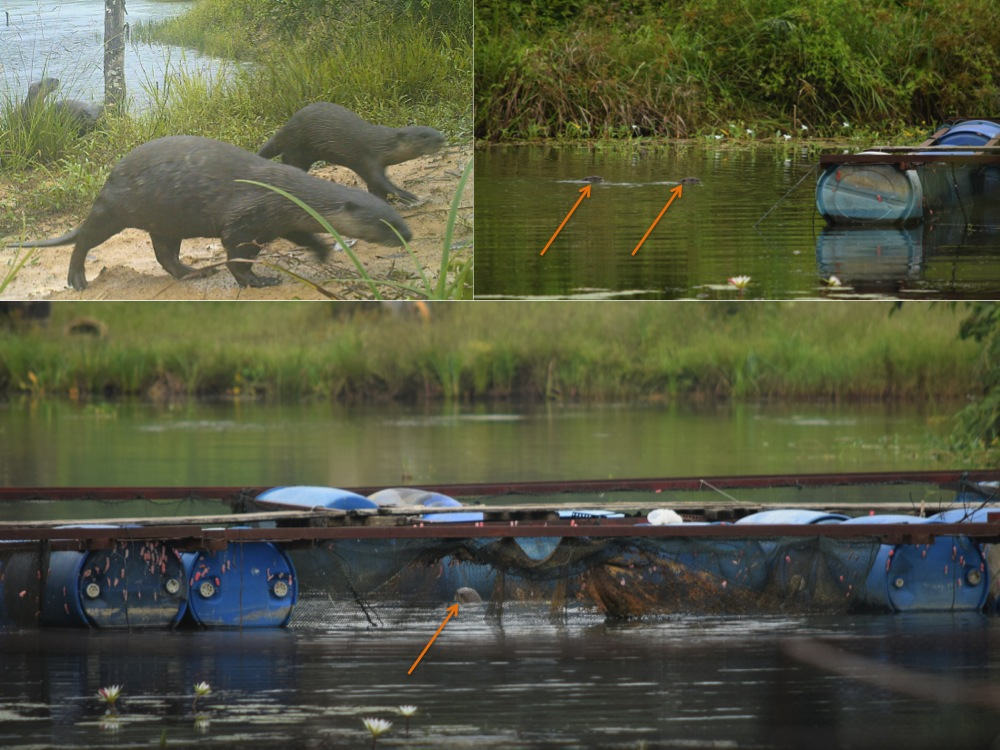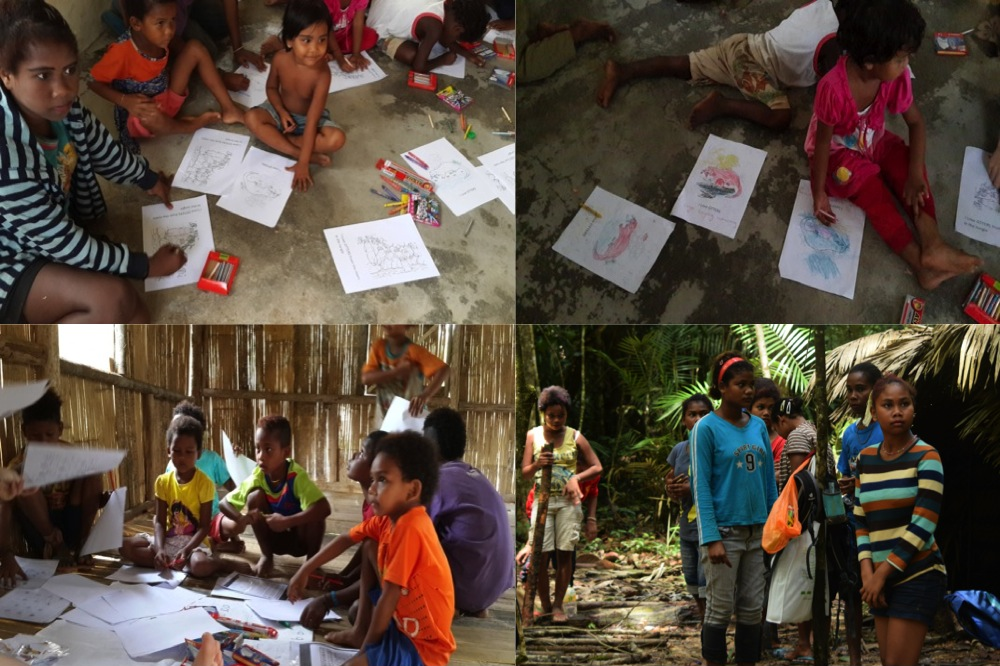IUCN/SSC Otter Specialist Group Bulletin

©IUCN/SCC Otter Specialist Group
Citation: Fernandez, K. (2018). Status of the Hairy-Nosed Otter (Lutra sumatrana) in Peninsular Malaysia. IUCN Otter Spec. Group Bull. 35 (2): 85 - 96
Status of the Hairy-Nosed Otter (Lutra sumatrana) in Peninsular Malaysia
Katrina Fernandez1
1 The Hermitage, Nersa, Khanapur Taluka, Belgaum dist, Karnataka, India – 591302 e-mail: katrina.fernandez@gmail.com
Received 25th January 2017, accepted 30th December 2017
Abstract: An individual, of one of the most elusive and endangered of the otter species, the Hairy-nosed Otter (Lutra sumatrana) was seen on the Sungai Relau in Taman Negara, Malaysia, in September 2013 almost two decades since the last recorded observation of the species in 1994, in Perak, another part of the peninsular (Baker, 2013). The project reported here was initiated in and around Taman Negara based on the 2013 observation, to gain a better understanding of the population size, habitat type, threats and the conservation measures required to improve the status of the Hairy-nosed Otter.
Unfortunately, 7 months of continuous camera trapping, riverbank surveys and observations along the Sungai Relau and the Sungai Ceruai resulted in no Hairy-nosed Otter records. However, the project confirmed the presence of Asian Small-clawed Otter (Aonyx cinereus) and Smooth-coated Otter (Lutrogale perspicillata) in and around Taman Negara National Park while highlighting a number of threats to otter species in the area and providing an overview of the attitudes of local people to otters and otter conservation, especially of the indigenous Bateq community.
Keywords: Hairy-nosed otter, Malaysia, Taman Negara, Asian Small-Clawed Otter, Smooth-Coated Otter
INTRODUCTION
Conservation Status of the Target Species, the Hairy-Nosed Otter
The Hairy-nosed Otter (Lutra sumatrana), is the rarest and least known among the five species of otter occurring in Asia. Little-recorded in most of its historical range, the species has been recorded in recent years in Thailand, Vietnam, Cambodia, Borneo and Sumatra. In 2013, the species was sighted along the western part of Taman Negara (Baker, 2013; N. Baker pers. comm. 2014) almost two decades since it was last seen anywhere in Peninsular Malaysia according to the records in Sasaki et al (2009).
Lutra sumatrana is listed in Appendix II of CITES and is legally protected in all of its range countries. The IUCN Red List categorizes L. sumatrana as Endangered (Hussain et al. 2012), due to a decline in its population throughout its distribution range.
Conservation Status of Smooth-Coated Otter and Small-Clawed Otter, the other Species represented in the Study
The Smooth-coated Otter (Lutra perspicillata) and Small-clawed Otter (Aonyx cinereus) have a wide distribution in tropical Asia. Both species are listed in Appendix II of CITES and are legally protected in all of their range countries. The IUCN Red List of Threatened Species categorizes L. perspicillata as Vulnerable and the Oriental Small-clawed Otter is listed as Near Threatened (Shenoy et al. 2006; Hussain et al. 2008), due to declines in their global populations.
Despite these efforts, global otter populations of all three species continue to decline in parts of their distribution range. Habitat loss and fragmentation due to logging - both for commerce, as well as development projects and agriculture (such as palm oil plantations), are some of the significant threats to Hairy-nosed Otter in particular. There is also the issue of reclamation of wetlands for human settlement, commercial fishing and aquaculture, which is resulting in reduction of habitat and increasing human- otter conflict.
Identifying the essential resources and the particular threat of a species may be helpful to formulating conservation strategies to ensure survival of that species. Actions directed towards conservation of flagship species of land ecosystems, such as Tiger Panthera tigris, are believed to have contributed to the conservation of a range of associated ecosystems and species. Otters are among the top predators of the aquatic ecosystem. Otters therefore are potentially ideal flagship species for conserving the rapidly degrading aquatic ecosystems of Malaysia.
OBJECTIVES
- To establish the presence of otter populations in Taman Negara, Peninsular Malaysia.
- To gather information on the habitat, ecology and threats to otter populations.
- To involve local communities, in the surveys and conservation process by getting them to participate in conservation and monitoring of otters.
METHODOLOGY
As a first step, we conducted verbal surveys in order to involve local communities from the beginning of the project with the idea of identifying species present and confirming their current status in Taman Negara. informal interviews were conducted through a translator allowing open answers by respondents. Respondents included individuals as well as groups.
The following questions were asked:
- Have you seen otters?
- Do you see otters often?
- Have you seen different types of otters?
- How many species/types of otters have you seen in this area? Describe the different types.
- Are these species/different types of otters seen in the same area/river/stream?
- Do you see more otters now compared to before?
- Have otter populations increased or decreased in the area?
- Do otters have a monetary value? ie live or dead trade?
- Does anyone in your community hunt otters?
- Do people like eating the meat of otters?
- Are otters a source of conflict with villagers? What conflict?
The second step was to conduct biological surveys along riverbanks to seek to confirm otter presence. This involved walking surveys on both banks of the Sungai (= River) Relau and Sungai Ceruai (Fig 1) A survey site was considered positive for otters if one or more signs (footprints, spraints [= faeces],slides, holts) were found or if any otter was sighted or camera-trapped. Otter signs, such as holts, slides, and food remnants were counted as a positive record only if supported by presence of either spraints or footprints. Remote camera traps with passive infrared heat-in-motion detectors were placed (Fig. 1) in areas where otter activities had been observed in order to capture images of otters. GPS coordinates were taken to record accurately and map the location of all field signs and the position of any photographs taken. Environmental parameters such as bank side geology (where signs were seen); water depth and distance of signs from water’s edge were collected in order to understand habitat preferences. Outreach and conservation work included talking to and sharing information with local and indigenous communities and encouraging these communities to participate actively in the project. Other aspects of my outreach program included university lectures, other public talks, the Borneo Wildlife Festival, my talk at the Fishing Cat Symposium in Nepal, on my blog, twitter, facebook and instagram
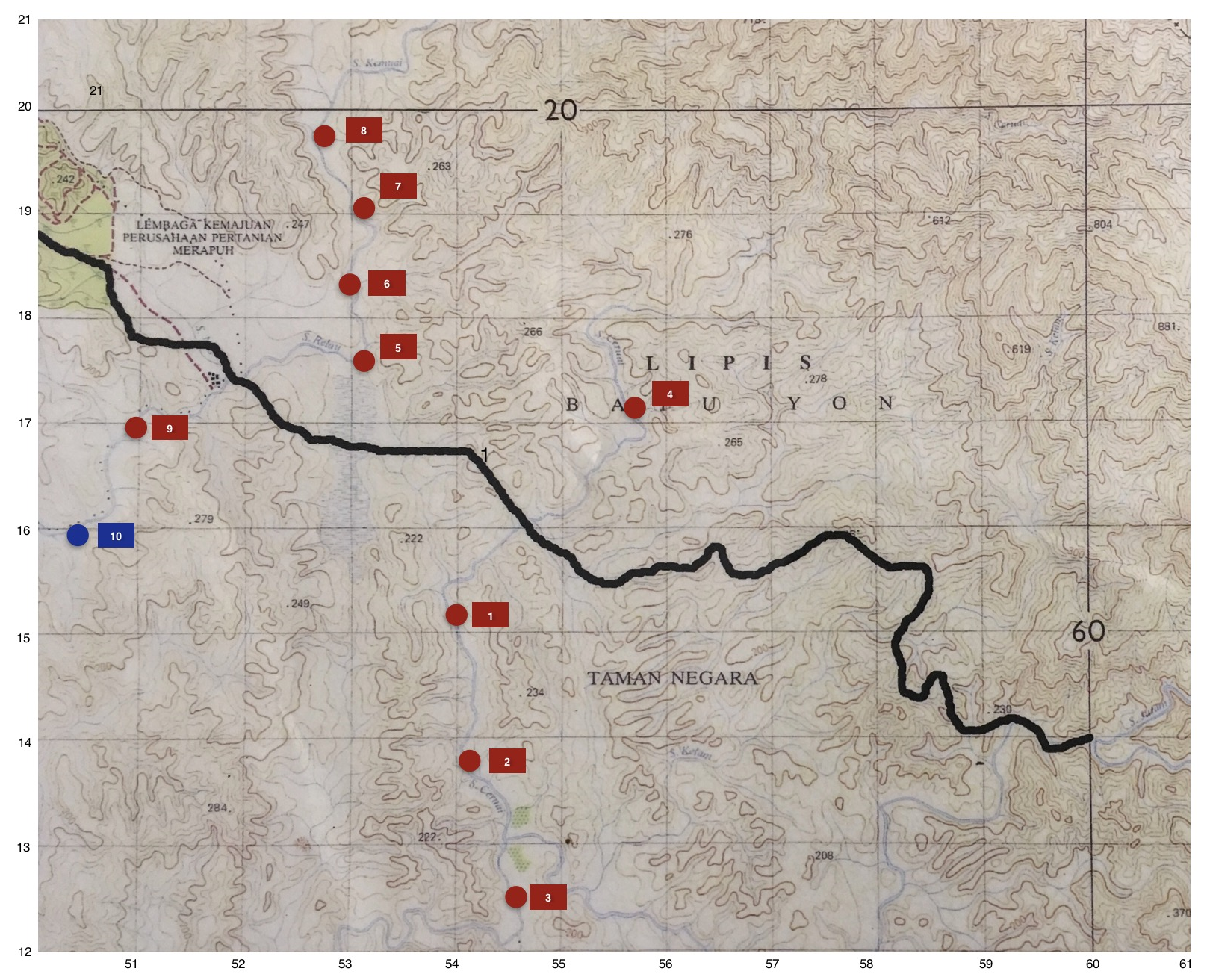
 = Camera Traps placed with corresponding camera trap number;
= Camera Traps placed with corresponding camera trap number;  = Stolen camera number 10;
= Stolen camera number 10;  = Access road within Taman Negara National Park.
= Access road within Taman Negara National Park. Source: Taman Negara National Park Office Merapoh
RESULTS AND DISCUSSION
Population assessment and Habitat Use:
Interviews
The majority of the feedback from twenty nine verbal surveys conducted in Merapoh, a village on the outskirts of the park, suggested that there were otters present both within the park and on the outside, including sightings in palm oil plantations, in agricultural areas and at local fish farms. Nineteen of the respondents replied that there were larger otters outside seen raiding fish farms, while 23 respondents also stated that smaller otters were seen in palm oil plantations. Size of the animals was the only distinguishing factor that respondents could identify with regards to variation between types. Respondents also indicated that poaching did occur and that the poachers were typically Indonesian and Thai nationals. From a historical perspective gained from the interviewees (17 respondents) it was suggested that the otter population have declined significantly in the last three decades. This information was gathered from a total of 29 respondents that included 18 individual interviews and the remaining 11 respondents were from a group setting that included plantation workers and subsitance fisherman. Individual respondents included, small farm holders, fish farmers, national park tourist guides and palm oil plantation workers
Five members of the indigenous Bateq community were interviewed as well but the respondents answered with caution and were not very forthcoming. I assessed the situation as them being wary of strangers and naturally suspicious. They did agree that there were two types of otter species (one larger than the other) and that these animals used to be seen more easily in the past. But the Bateq also said that that this was likely to be because they, as a community, do not now much venture into the national park and depend less on its resources, than they did in the past and so the chances of encountering the animals now are slimmer. They also said that the community used to hunt and eat otters in previous generations but suggested that chicken was now a cheaper and more viable option as sustenance. However, neither the indigenous community members nor the other local inhabitants were able to recognize (in photo surveys of the four different species in tropical Asia or describe any individual characteristics of a type of otter other than size. So the verbal surveys proved inconclusive in terms of my search for the Hairy-nosed Otter in particular.
Habitat characteristics within Taman Negara
Of the 48 positive otter sites recorded in this study, within the boundaries of Taman Negara, i.e. where an otter sign was present, 36 were spraint sites, of which 22 were combined with clear prints. Another five of the positive otter sites were holts, of which two were combined with prints and one with spraint and the remaining seven positive otter sites consisted of footprints and grooming sites. All 48 otter sites were positively identified as Small-clawed Otter based on spraint type (size, shape and smell) and footprint (size and shape).
Spraints were deposited on rocks (71%) and on sandy slopes (29%). These sand slopes were also used as grooming sites and slides. Rock spraints were at an average of 1.8 meters away from the water’s edge and sand sprints were on average 2.8 meters away from the waters edge. Preference for grooming and resting sites included areas with sandy beaches, with 70% to 80% canopy cover and thick surrounding undergrowth vegetation. 80% of grooming sites had small inlets/streams that led into the main river. These inlets/streams were on average 1.4 meters wide and had slow-flowing water.
Habitat characteristics on outer boundary of Taman Negara
The area that forms a boundary with the park consists of agricultural land. This includes palm oil plantations as well as smaller agricultural farms belonging to the people living in the village of Merapoh. Several old abandoned tin mines in the area have naturally converted into lakes. These old tin mine lakes have become natural reservoirs and suitable habitats for Smooth-coated Otters. A few of these lakes have subsequently further been developed into small-scale aquacultures. Four of these lakes were monitored during the course of the study. Two of the four were natural with no current, active human presence/disturbance and the remaining two were small aquaculture ponds.
The natural tin mine lakes were surrounded by vegetation that comprised primarily tall grasses and reeds (70%) and some smaller secondary forest tree species (30%) that provided 20% canopy cover. Here there were no direct sightings of otters but there were positive Smooth-coated Otter signs (17) during 3 separate survey visits.
The remaining two tin mine lakes with the small aquaculture operations had Smooth-coated Otter visits on a daily basis. These lakes were also surrounded by grasses and reeds (90%) with a few small shrubs and trees surrounding the lakes (10%). There was no canopy cover in this area and the lakes were adjacent to human habitation. These otters were habituated to human presence and all efforts by the owners to scare them away proved unsuccessful and resulted in them having to shut down their aquaculture farms towards the end of 2015. Tactics used to scare them away included using scarecrows, making noises and being physically present so that the otters did not approach the holding tanks. Camera traps were not placed at these sites, as this was not the target species of this study.
Camera traps
A total of 4,707 camera trap images were recorded from a total of 1557 camera trap nights from 9 cameras (Fig 1). Four cameras were placed in positively identified otter sites along the Sungai Ceruai and six cameras were placed similarly on the Sungai Relau. One of the cameras on the Sungai Relau (camera #10) was illegally removed from the site by unknown person/persons. All that remained at the site were the visible marks (on the tree trunk) of the knife used to break through the python lock that had secured the camera to the tree.
Of the 4,707 images recorded, 341 images were blanks. Of the 341 blank images, 142 (12.79%) were notionally independent (defined as photos recorded more than half-an-hour from the proceding or succeeding image). The remaining images included 927 notionally independent encounters of mammals (864 = 77.83%), birds (33 = 32.97 %) and reptiles (30 = 32.70%). There were 41 (43.69%) notionally independent observations of human beings in the park. Some of these can be positively identified as poachers (Fig. 2).
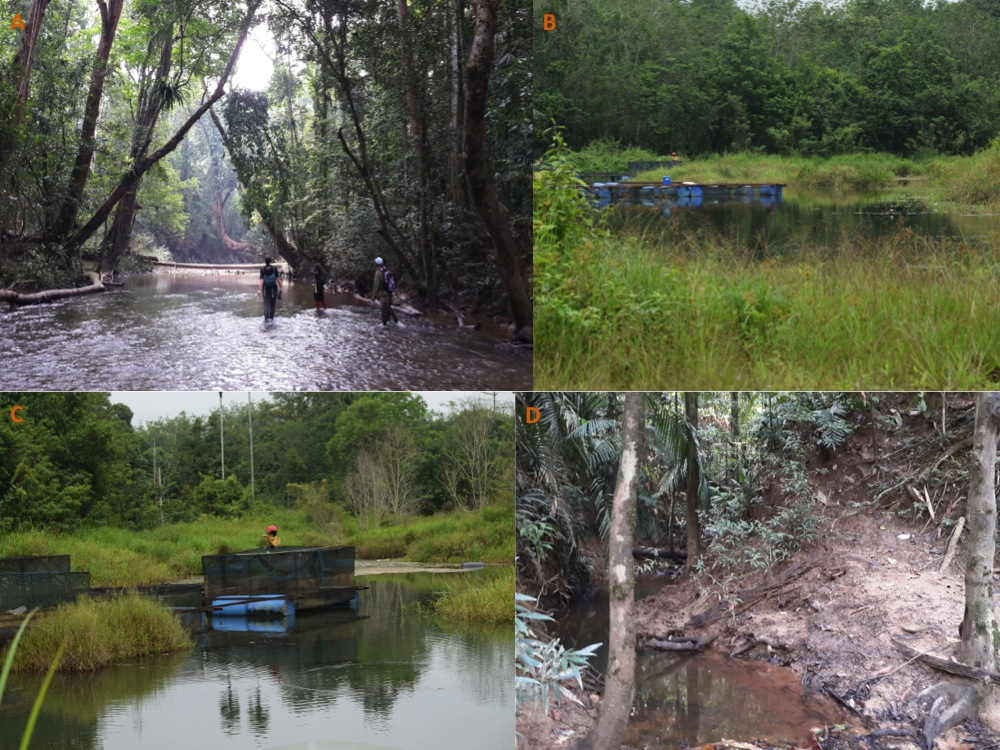
A: Sungai Relau - Small-clawed Otter habitat,
B and C: Tin Mine Lakes converted to Fish farms - Smooth-coated Otter habitat,
D: Small streams leading into Sungai Ceruai – Small-clawed Otter habitat
A total of 54 (5% of total records and 6% of mammal records) notionally independent photographs of Small-clawed Otter were recorded across all stations on the Sungai Ceruai and in two out of the 5 stations on the Sungai Relau. The most observations were made on the Sungai Ceruai. (Table 1). Although, all camera trap photos were by day with most images recorded in the morning between 7am and 11 am, this is not a conclusion to activity patterns of the Small-clawed Otter.
Wild Pig (Sus scrofa) accounts for 69% of the 4707 images recorded and 41% of notionally independent images and was the most frequently recorded animal. Areas with the highest wild pig activity had few or no otter records. More study needs to be conducted in order to check whether there is a correlation between wild pig activity and otter presence.
Threats:
Within the park camera trap photos provide evidence of poachers walking along the banks of the Sungai Ceruai in areas where otters were present (Fig. 3). The trade in live otters as well as in their fur and other body parts is still significant in South East Asia (Gomez et al., 2016) and although the photos provide no direct evidence that otters are the target species of these poachers, it is significant that there are poachers in the park area and that they are active in areas where otters are present. Another significant finding was that in areas on the Sungai Relau where there was tourist activity, Small-clawed Otter activity was less compared to the Sungai Ceruai, which has no tourist activity at all (Table 1). Whether this difference results from effects of tourist visitation or simply reflects inherent differernces between the streams cannot be determined. Given that the Sungai Relau had more tourism and less otters and the Ceruai had no tourism, more otters but also evidence of poachers, it could be possible that tourism reduces poaching activity so thre is the possibility that while it might also reduce otter activity, its overall effect on otters in a situation of poaching cannot be predicted.
Illegal gold mining (Fig. 4) is presently a looming threat to otter habitat in the area. Evidence of small operators was seen along parts of the river (Fig. 4), and aside from the disturbance of this activity there is opportunity for poaching alongside. A significant portion of the boundary of Taman Negara has been converted to Oil Palm plantation. This results in agricultural pollutant runoff entering local streams that then drain into the larger rivers. This is a potential threat to the prey species, resulting in reduction of prey biomass, but also a direct threat to the Small-clawed Otter especially if using organochlorides. More studies need to be conducted in this area to be more conclusive.
Conservation and Outreach
All of my outreach work was conducted outside the national park as per the requirements of my research permits. All of the community outreach was done in the villages of Merapoh of the Bateq village.
Bateq – Through my interaction with the Bateq people and by showing them numerous images of different species of otters I had gathered that their identification skills for the different species was inconclusive. Over time, working with me, my guides learned to identify two different species (A. cinereus and L. perspicillata) based on their physical appearance as well as the subtle differences in their faeces (smell, texture and contents) and foot prints. I have seen these skills being passed on to the next generation. My field assistant, Angela Smith, and I spent 2 afternoons a week interacting with the Bateq children (of all ages), teaching them English and incorporated otters into their English language learning activities. We also gave them drawing and colouring exercises that included otters (Fig. 6). We had photo and video sessions. We also took them to jungle school, which was a day out in the jungle, walking along the riverbanks trying to identify different footprints, significant vegetation in the area and other signs of wildlife. Quantifying the outcomes of working with the Bateq has not been possible. The number of children we interacted varied from visit to visit and even during a particular visit. Children would join the group and leave and then return. What we can quantify was the ability of the children (in most scenarios as a collective) to start recognising different characteristics amongst otter species through photographs and videos.
The non-indigenous local communities – I spent a lot of time with the local farmers, some of whom were trained guides employed by the National Park to take tourists into the park. I used photos and videos of otters to capture their interest in the animals and eventually showed them what to look for in the field and why they are important and need to be protected. Similar strategies were used in local schools as well. This resulted in my getting notified when an otter was spotted any where in a 50 Kilometre radius of Merapoh village. This was very useful for me to keep track of otter presence and confirm this presence by surveying that area.
Outreach outside local communities
I was able to give public lectures (via Monash University), increased my network via TRAFFIC South East Asia, spoke to people who walked the Tiger Trails through MYCat, presented at the Borneo Wildlife Festival, engaged with ECOTEER volunteers and their teams, engaged with foreign tourists that were visiting the National Park. I also use social networking as a tool to keep people interested and updated. I also took groups of people out of Kuala Lumpur on weekends to explore the Tin Mine lakes and to learn otter identification skills and give them a first hand experience of otter habitats and conservation efforts.
CONCLUSIONS
Camera trapping and extensive surveying yielded no evidence of the Hairy-nosed Otter along the Sg Relau and Sg Ceruai in Taman Negara. The rivers within Taman Negara as well as the Sungai Yu, which is in the corridor outside the park, is a thriving habitat, supporting a good population of Small-clawed Otter.
This study has been instrumental in contributing to the knowledge on the habitat preferences, ecology and threats of the Smooth-coated Otter and the Small-clawed Otter in and around Taman Negara. All of these topics are important information for conservation. These are also significant when considering engaging local communities because a large number of local guides from Merapoh village support tourism within the park. There are also park rangers, oil palm plantation workers and owners (otters have been seen in the streams on their properties) and fishing communities. As iconic and flagship species, otters can be used to draw attention to larger issues such as water quality, habitat degradation, and chemical pollution from pesticide runoff, mining and tourism exploitation and other anthropogenic activities that will have an impact on the river ecosystem. Otter conservation will increase awareness, regulating the fishing and tourism activities, reducing habitat fragmentation and will provide protection and result in a healthy wetland habitat since otter presence indicates good water quality. I continue to advocate for these species in Malaysia and else where in Asia.
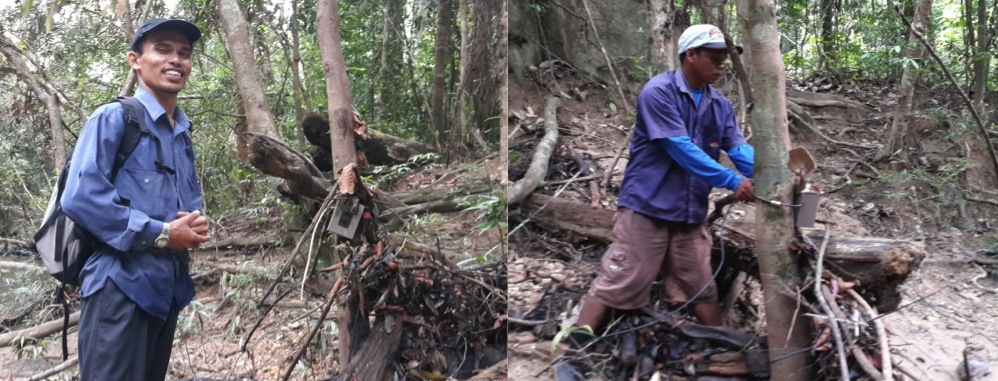
The search for the Hairy-nosed Otter needs to be extended to other areas in the peninsular. A lack of knowledge about the different otter species that are present in the region, and their importance in their ecosystem, and how these animals are exploited in the pelt and pet trade amongst many other threats are some of the factors that need to be addressed. From my experience, this past one year, involving the community is a necessary and significant approach to otter conservation in the region. Talking to people, showing them images of otters and detailing the threats they face seems to have made a difference in attitudes towards the species, at least in the short-term.

Acknowledgements: Many thanks to the Rufford Foundation and the Prince Bernhard Foundation for the grants that made this project possible. Many thanks also to Monash Univeristy, Malaysia and the Centre for Marine and Coastal Studies, Universiti Sains Malaysia. Both of these institutions provided the necessary administrative support as well as technical guidance in order to carry out field work in the region.
REFERENCES
Baker, N. (2013). New Records of Hairy-nosed Otter (Lutra sumatrana) in Peninsular Malaysia, IUCN Otter Spec. Group Bull. 30(2): 112 - 118
Gomez, L., Leupen, B T.C., Theng, M., Fernandez, K., and Savage, M. (2016). Illegal Otter Trade : An analysis of seizures in selected Asian countries (1980-2015). TRAFFIC. Petaling Jaya, Selangor, Malaysia.
Hussain, S.A., De Silva, P.K., Feeroz, M.M. (2008). Lutrogale perspicillata. In: IUCN 2013. IUCN Red List of Threatened Species. Version 2013.2.
<www.iucnredlist.org>. Downloaded on 22 December 2014.
Kruuk, H. (2006). Otters: ecology, behaviour and conservation. Oxford University Press, New York, USA. 265pp.
Nawab, A., Gautam, P. (2008). Living on the edge: Otters in developing India. In Wetlands – The Heart of Asia. Proc. Asian Wetland Symp., Hanoi, Vietnam.
Sasaki, H., Burhanuddin, M.N., Budsabong, K. (2009). Past and present distribution of the Hairy-nosed Otter Lutra sumatrana Gray 1865. Mammal Study 34: 223-229
Shenoy, K., Verma, S., Prasad, K.V.D. (2006). Factor determining habitat choice of Smooth-coated Otter, Lutra perspicillata in a South Indian river system. Curr. Sci. 19, 637-643
Statut de la Loutre de Sumatra (Lutra sumatrana) dans la Péninsule de Malaisie
Un individu, de l’une des espèces de loutre les plus insaisissables et menacées, la loutre de Sumatra (Lutra sumatrana), a été aperçu sur le Relau Sungai dans le Taman Negara, en Malaisie, en septembre 2013, presque 20 ans après la dernière observation de l’espèce en 1994, à Perak, une autre région de la péninsule (Baker, 2013). Le projet mentionné ici a été initié dans et autour de Taman Negara et est basé sur une observation datée de 2013, pour avoir une meilleure compréhension de la taille de la population, du type d’habitat, des menaces et des mesures de conservations nécessaires à l’amélioration du statut de la loutre de Sumatra.
Malheureusement, 7 mois d’utilisation continue de pièges photos, d’étude des berges et d’observations le long du Sangai Relau et du Sungai Ceruai n’ont pas permis d’obtenir de données sur la loutre de Sumatra. Cependant, le projet a confirmé la présence de la loutre cendrée (Aonix cinereus) et à pelage lisse (Lutrogale perspicillata) dans et autour du parc national de Negara, mettant également en évidence un certain nombre de menaces pour les espèces de loutre présentes dans la zone et fournissant un aperçu des attitudes de la population locale, spécialement la communauté indigène Bateq, vis-à-vis des loutres et de leur protection.
Revenez au dessus
Resumen: Status de la Nutria de Sumatra (Lutra sumatrana) en Malasia Peninsular
En Septiembre de 2013, fue avistado un individuo de una de las especies de nutria más elusivas y amenazadas, la Nutria de Sumatra (Lutra sumatrana), en Sungai Relau, en Taman Negara, Malasia; casi dos décadas después de la última observación registrada de la especie en 1994 en Perak, otra parte de Malasia peninsular (Baker, 2013). El proyecto informado aquí fue iniciado en y en alrededores de Taman Negara, en base a la observación de 2013, para obtener un mejor entendimiento del tamaño poblacional, tipo de hábitat, amenazas y medidas de conservación requeridas para mejorar el status de la Nutria de Sumatra. Desgraciadamente, 7 meses de monitoreo continuo con cámaras-trampa, relevamientos de riberas de ríos y observaciones a lo largo de Sungai Relau y el Sungai Ceruai, no resultaron en ningún registro de la Nutria de Sumatra. Sin embargo, el proyecto confirmó la presencia de nutria de uñas pequeñas asiática (Aonyx cinereus) y nutria lisa (Lutrogale perspicillata) en y alrededor del Parque Nacional Taman Negara, al mismo tiempo que permitió detectar un número de amenazas a las nutrias en el área y proveer un panorama de las actitudes de los habitantes locales hacia las nutrias y su conservación, especialmente la comunidad indígena Bateq.
Vuelva a la tapa

